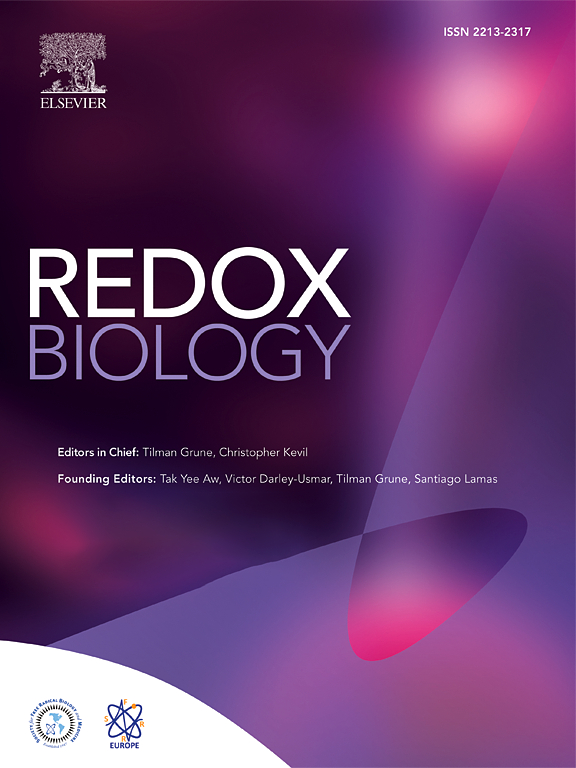IDO1通过促进内皮细胞NAD+新生合成和抑制内皮细胞衰老来改善衰老小鼠的缺血后新生血管形成
IF 11.9
1区 生物学
Q1 BIOCHEMISTRY & MOLECULAR BIOLOGY
引用次数: 0
摘要
外周动脉疾病(PAD)在老年人中普遍存在,治疗性新生血管是PAD治疗的研究热点。补充烟酰胺腺嘌呤二核苷酸(NAD+)前体是促进新生血管形成的重要途径,但在老年PAD患者中的临床试验显示有限的成功。本研究旨在寻找提高老年PAD患者NAD+水平以促进新生血管形成的有效途径。方法对缺血后肢肌内皮细胞(ECs)进行转录组学和NAD+靶向代谢组学分析。用全基因敲除小鼠研究了吲哚胺2,3-双加氧酶1 (IDO1)在缺血后新生血管中的作用。通过转录组学和功能实验研究IDO1表达的调控机制。在体内和体外研究了IDO1蛋白对缺血后新生血管的影响。测定青年和老年PAD患者血浆IDO1水平,并与PAD临床指标进行相关性分析。结果老龄小鼠ECs中NAD+ de novo合成和IDO1转录减少。IDO1缺乏导致年轻小鼠内皮细胞NAD+新生合成下降,内皮细胞衰老,新生血管受损。升高的IL-17A/F通过CREB抑制IDO1的转激活,损害新生血管。IDO1可缓解老年小鼠内皮细胞NAD+新生合成下降和内皮细胞衰老,促进新生血管形成。老年PAD患者血浆IDO1水平较低,与疾病严重程度、发病风险和心血管结局呈正相关。结论ecs NAD+代谢失衡是由NAD+新生合成减少引起的,以IDO1为靶点提高NAD+水平可能是老年PAD患者潜在的治疗方向。本文章由计算机程序翻译,如有差异,请以英文原文为准。

IDO1 improves postischemic neovascularization in aged mice by boosting endothelial NAD+ de novo synthesis and curbing endothelial senescence
Introduction
Peripheral arterial disease (PAD) is prevalent among the elderly, and therapeutic neovascularization is a research hotspot in PAD treatment. Supplementing nicotinamide adenine dinucleotide (NAD+) precursors is an important approach for promoting neovascularization, but clinical trials in the elderly PAD patients have shown limited success. This study aims to find effective ways to boost NAD+ levels in elderly PAD patients to enhance neovascularization.
Methods
Transcriptome and NAD+-targeted metabolomics analyses were conducted on ischemic hindlimb muscle endothelial cells (ECs). The role of indoleamine 2,3-dioxygenase 1 (IDO1) in postischemic neovascularization was studied using global knockout mice. Mechanisms regulating IDO1 expression were investigated through transcriptomics and functional experiments. The effects of IDO1 protein on postischemic neovascularization were evaluated in vivo and in vitro. Plasma IDO1 levels were measured in young and elderly PAD patients and correlated with clinical indicators of PAD.
Results
In aged mice, ECs exhibited decreased NAD+ de novo synthesis and IDO1 transcription. IDO1 deficiency induced the decline of ECs NAD+ de novo synthesis and ECs senescence, impaired neovascularization in young mice. Elevated IL-17A/F inhibited IDO1 transactivation via CREB, impairing neovascularization. IDO1 administration alleviated the decline of ECs NAD+ de novo synthesis and ECs senescence, and enhanced neovascularization in aged mice. Plasma IDO1 levels were lower in elderly PAD patients, correlating positively with disease severity, onset risk, and cardiovascular outcomes.
Conclusion
ECs NAD+ metabolism imbalance is driven by decreased de novo synthesis of NAD+ and targeting IDO1 to elevate NAD+ levels could be a potential therapeutic direction for elderly PAD patients.
求助全文
通过发布文献求助,成功后即可免费获取论文全文。
去求助
来源期刊

Redox Biology
BIOCHEMISTRY & MOLECULAR BIOLOGY-
CiteScore
19.90
自引率
3.50%
发文量
318
审稿时长
25 days
期刊介绍:
Redox Biology is the official journal of the Society for Redox Biology and Medicine and the Society for Free Radical Research-Europe. It is also affiliated with the International Society for Free Radical Research (SFRRI). This journal serves as a platform for publishing pioneering research, innovative methods, and comprehensive review articles in the field of redox biology, encompassing both health and disease.
Redox Biology welcomes various forms of contributions, including research articles (short or full communications), methods, mini-reviews, and commentaries. Through its diverse range of published content, Redox Biology aims to foster advancements and insights in the understanding of redox biology and its implications.
 求助内容:
求助内容: 应助结果提醒方式:
应助结果提醒方式:


